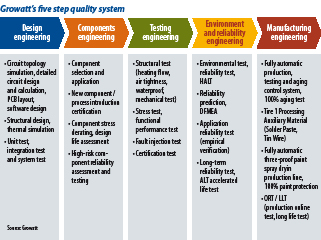Growatt’s company culture is based on two principles: ‘product quality is the company’s lifeline’ and ‘reliability comes first.’ The company leans on these principles for providing the foundation for its success in the more than 100 countries where Growatt’s products have been installed. The manufacturer shipped approximately 5 GW of products in 2019, and is set to open a new factory in Huizhou near Shenzhen this year with an annual production capacity of 10 GW.
Five-step quality system
Ensuring quality and reliability at such an expanded scale is no small chore. To achieve the level of success at such large scale, the company says it relies on five quality steps, which together provide a rigorous quality framework. As the illustration on page 16 shows, the first step involves design engineering. This is followed by components engineering, which involve sophisticated lab tools such as metallographic microscopes and stereo microscopes to screen for component deficiencies. The next step, shown in green in the illustration, involves testing engineering. The company’s new products not only pass the company’s rigorous testing and verification department, but also go through more than 20 certification systems adopted by various countries in the world.
The final two steps include environment and reliability engineering and manufacturing engineering inside the factory. Since PV inverters must perform reliably for many years, long-term reliability tests validate Growatt’s inverters continue to function in a reliable manner even in challenging environments. The final quality step in the five step program is manufacturing engineering, where state-of-the-art production facilities play an important part in ensuring the consistent quality of Growatt’s products. Based on serial number, the manufacturer can identify the specific components and production steps that went into each product.
A special class of electronics
In some ways, PV inverters are similar to conventional electrical home appliances. However, a fundamental difference is that when the inverter is running, with high current, high voltage, and high temperatures, the power is tens to hundreds of times that of typical home appliances. PV inverters frequently are not installed in comfortable indoor temperatures, and regularly face harsh environments with temperature fluctuations, humidity, and extreme weather conditions – challenging both quality and reliability of the electronic equipment. Over the past 10 years, Growatt has made this challenge its priority.
DPA testing
As part of Growatt’s full quality control process, the company operates outdoor testing sites, where new products can be put to the test in harsh weather conditions. In the case of the MAX 50-100K C&I inverter model awarded with TÜV Rheinland’s ‘All Quality Matters’ seal, outdoor testing revealed issues with the freewheeling diode in the boost circuit’s power module, whereby the diode had been damaged in severe weather conditions with thunderstorms. The diode fault was triggered by a mismatch between the inrush current and the rated current of the component. This conclusion was found through the company’s components engineering quality step, whereby Growatt’s special components reliability department performs a wide range of tests on individual inverter components. For example, in the case of relays, these tests include X-Ray inspection, microscope observation, and DPA (destructive physical analysis) testing. Growatt is one of only several inverter manufacturers in the world to use DPA analysis technology to aid in product design. Both the metallographic and stereo microscope are essential tools in performing such analysis. In the case of the MAX 50-100K it was DPA analysis that revealed the module diode problem in the boost circuit, and then helped the R&D team to determine the best solution, followed by subsequent tests to verify that the problem had been thoroughly solved.
Better O&M, and the integration of storage
Growatt’s ‘reliability comes first’ mantra also serves to reduce O&M costs out in the field. With rapidly declining costs of battery energy storage, PV systems are increasingly equipped to store clean energy as part of the distributed energy resource system. The company says that by offering products and solutions with a high degree of quality and reliability, it is able to reduce the number of O&M truck rolls to the customer site, thereby further reducing the levelized cost of energy (LCOE) of the installed system.
As solar+storage systems become increasingly popular, Growatt forecasts that approximately 30 percent of the company’s shipments will be in the battery storage category this year. Sourcing battery cells and modules from top-tier specialist manufacturers, Growatt then adds further capabilities to the battery product, including the battery management system and the housing of the battery unit. With the company’s five step quality system integrated firmly in place, we can expect battery technology from Growatt to exhibit the same level of performance and stability the industry has come to value in the ten years the manufacturer has supplied the world with in its wide range of on- and off-grid inverters.
This content is protected by copyright and may not be reused. If you want to cooperate with us and would like to reuse some of our content, please contact: editors@pv-magazine.com.
